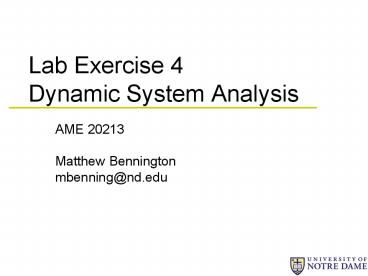Lab Exercise 4 Dynamic System Analysis PowerPoint PPT Presentation
1 / 22
Title: Lab Exercise 4 Dynamic System Analysis
1
Lab Exercise 4 Dynamic System Analysis
- AME 20213
- Matthew Bennington
- mbenning_at_nd.edu
2
Outline
- Introduction and Objective
- First Order System
- Second Order System
- Background and Equipment
- Part I
- Part II
- Part III
- Grading
- Schedule
- Testing Matrix
3
Intro and Objective
- Dynamic Response Characterization
- To Understand a Systems Response to a Given
Input - Objective To Characterize A First (Part I),
Second Order System (Part II) and Unknown Order
System (Part III).
4
First-Order System
General Equation
Time Constant
For Part I
5
First-Order System
Solution
6
First Order System (Cont.)
- Response to Step-Input Forcing
System Response
M(t)1 e-t/t
M(t)0.632 _at_ t/t1
7
Second Order System
Damping Ratio
Natural Frequency
For Part II
8
Second Order System
9
Equipment
- Thermocouple
- Digital Oscilloscope (DO)
- Frequency Generator (Model will Vary)
- RLC Circuit
- Unknown Circuit
10
Part I Experimental Setup
TRJA
Digital Oscilloscope
Thermocouple
Ice Bath
11
Part I Data
To
12
Part I Data
13
PART II Experimental Setup
Digital Oscilloscope
2
Function Generator
RLC
1
14
Part II Electric Circuit (RLC)
Variable Resistor R 1 O to 910 O
L 5 mH (R 9.0 O)
Eo
Ei
C0.68 µF
15
Data Part II
?t
Eo
Ei
16
Data Part II
.
17
Data Part II Cont.
F(?)
M(?)
?/?n
?/?n
18
Part III Experimental Setup
Digital Oscilloscope
2
Function Generator
??
1
19
Part III Data
20
Grading-LAB REPORT
- Deliverables
- 1) Plot the thermocouple data and determine the
time constant directly. Transform the variables
and perform a linear least-squares regression
analysis. From that determine the time constant.
Compare the time constants obtained from the two
methods. Which method is more accurate and why? - 2) From your knowledge of the thermocouple, which
(A or B) would have a larger time constant and
why? - 3) Complete RLC response data table
- 4) Using these results and a program or M-fle,
construct two plots on of M(?) and other of F(?)
versus the normalized frequency ratio. These
plots must contain the data along with the
theoretical curves. - 5) Does the data support the conclusion the RLC
circuit behaves as a second-order system in both
cases? Finally, compare the values of the
damping ratio found with the value of R/Rc. Do
this by comparing the data with the corresponding
values determined using various values of R/Rc
in the given equations. How well do the
experimental and theoretical values of ? compare? - 6) Identify the range over which the unknown
circuit varies in Magnitude ratio the most. With
the data from this range identify what type of
system the unknown circuit represents.
21
Schedule, etc.
- 2 students per group, duplicate group s are not
allowed - Variation Achieved by choosing different
thermocouples, assigning different Variable
Resistance Values and Frequency Multipliers and
different unknown circuit settings - Use Technical Report Format
- Chapter 3 of the text for guidelines
- Lab will be run in Fitzpatrick B 14
- Be there for the day you sign up, no excuses.
22
Test Matrix
6
7
5
4
8
3
9
Resistor Dial Setting
2
10
11
1
Frequency Multiplier (K)
Max
Min

